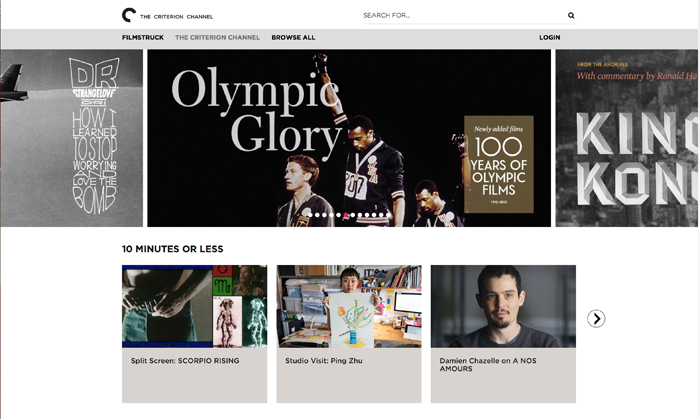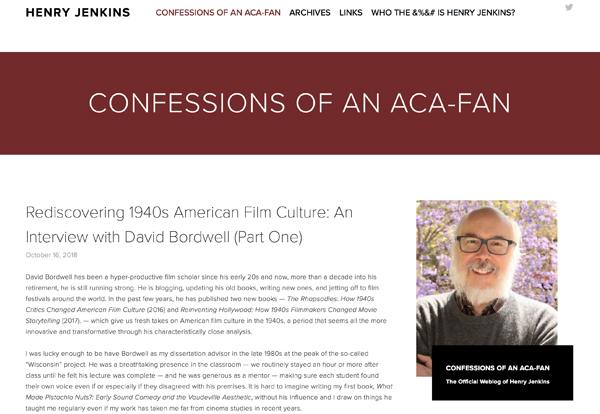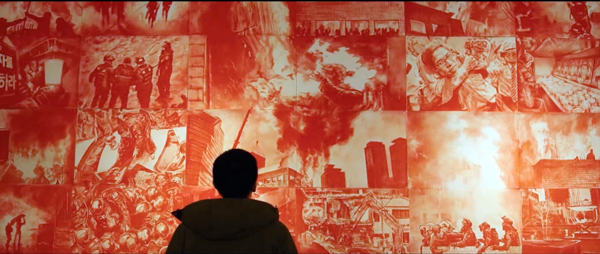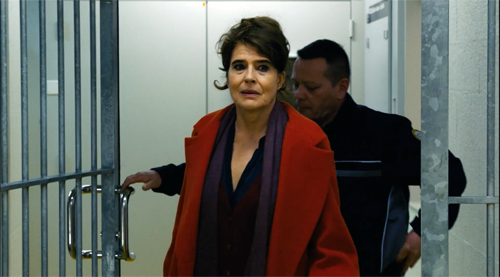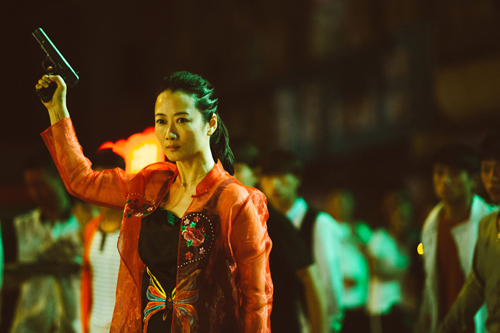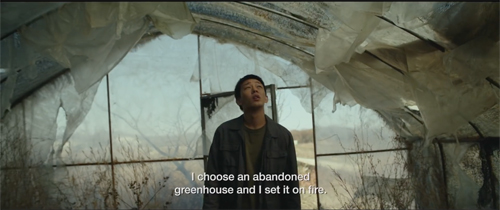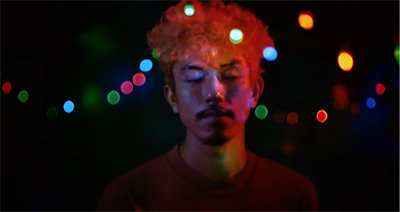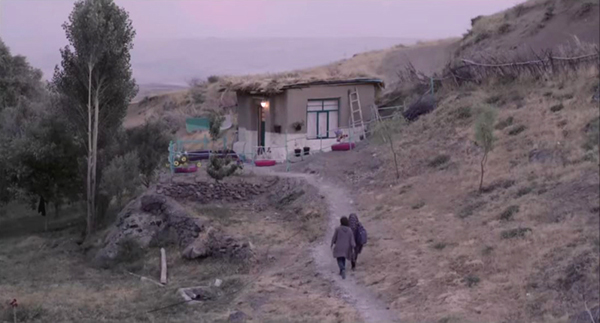
Kristin here:
As I write, David and I have been at home after the Vancouver International Film Festival for one week. Between Venice and Vancouver, I saw about 40 films, some of them likely awards competitors for the year and some more modest works that need to be sought out at festivals and big-city art-houses. (Today, in a cyclical gesture, we’re going back to the very first film we saw at Venice, First Man, this time in IMAX.)
During any festival there’s never time enough to write up comments on all the films we see. This is our last report on the 2018 Vancouver event, this time dealing with Middle Eastern films and one from South America.
3 Faces (Jafar Panahi, 2018)

3 Faces begins startlingly, with a vertical cell-phone image of a girl in a rocky area, dictating a suicide note as she walks. She identifies herself as Marziyah, a peasant girl who aspires to be study acting but whose conservative family (along with their entire village) have blocked her from doing so. She has written repeatedly to a famous TV actress, Behnaz Jafari (played by herself) for help, but receiving no response, she has decided to kill herself. The recording ends as the girl apparently hangs herself and the camera falls.
The image opens to fullscreen as Jafari, riding in a car with Panahi, watches the recording, distraught at the possibility that she has failed to help the girl. She also wonders whether Marziyah has really killed herself. Was the film edited to create that impression? Panahi thinks it looks authentic, and he drives Jafari out to the girl’s village to find out.
3 Faces is the fourth feature Panahi has made since his trial in 2010 and the resulting sentence banning him from filmmaking for twenty years. We had been following his career before that, most notably with The Circle and Offside. In happier days, David met Panahi briefly at the Hong Kong Film Festival, when they sat next to each other at an award ceremony. David posted an account of Panahi’s charges and sentencing in 2010. We have also written about films that Panahi has made since then: This Is Not a Film and Closed Curtain. Somehow, though we saw Taxi, we didn’t blog about it. Today Panahi remains unable to leave Iran to attend the festivals where his films are honored (3 Faces won the best-screenplay award at Cannes), and he has no access to studio facilities.
With 3 Faces, Panahi has moved on from making films about his plight and looks at the repression suffered by women and girls in the rural areas of Iran.
This time he follows the classic quest pattern of many of the golden age of Iranian cinema from the 1980s to the early 2000s. 3 Faces is perhaps most reminiscent of Kiarastami’s And Life Goes On, another director’s journey to the countryside to check on a child who may have died. It’s gratifying to see the fruitful quest pattern revived, and Panahi creates a work that is at once familiar and uniquely imaginative. The settings, mostly in Panahi’s car and the countryside of Iran near the Turkish border.
As in other such films, 3 Faces is as much about the unexpected encounters with strangers along the way: a wedding group celebrating on a steep mountain road, a woman testing out her own grave to make sure it’s comfortable, an old man who introduces Panahi to the patterns of honks locals use when approaching each other on the narrow roads. Upon reaching the village and encountering Marziyah’s family, it becomes apparent that they are baffled and annoyed by the girl’s ambitions to devote herself to a frivolous career rather than marry and settle down.
Jahari also encounters a retired actress from before the 1979 revolution, Shahrazade, now a recluse living in a tiny house near the village (see top). The “3 Faces” title apparently refers to the three generations of actresses, Shahrazade, Jafari, and Marziyah. This explanation is not apparent from the film, especially since Shahrazade is glimpsed only in extreme long shot from the back as she paints in a field.
Panahi has made a more acerbic film than those of Kiarostami, poking fun at the villages and especially emphasizing the way the men are obsessed with virility and controlling their womenfolk. Receding into the background despite his major role, Panahi takes p the feminism he displayed in Offside and reveals the more serious lack of freedom women and girls experience in rural areas. He does so without abandoning the humor that underlies many of the quest films.
Kino Lorber will distribute the film in the US, with a release planned for March, 2019.
Dressage (Pooya Badkoobeh, 2018)
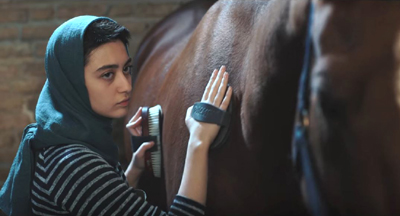
Another trend in recent Iranian cinema might be termed the Farhadi effect. Asghar Farhadi has become the most prominent of the current group of Iranian directors, winning best foreign-language Oscars for both A Separation and The Salesman. His films tend to center around a serious mistake or a crime committed early on, with the varying reactions of the characters forming the bulk of the drama. In some cases sudden twists reveal motivations that tend to make the situation more ambiguous morally, and the rights and wrongs of the situation do not resolve clearly.
Dressage, Badkoobeh’s first feature, fits this pattern to some degree. A group of middle-class and upper-middle-class students are in the habit of robbing shops for thrills. As the film opens, they have robbed a small grocery store. When a clerk who lives in the store unexpectedly interrupts them, their leader knocks him out. Having fled, the group discovers that they have neglected to take the incriminating surveillance tape with them. The protagonist, sixteen-year-old Golsa, is sent back for it. Having retrieved it, she hides it in a bin at the stables where she helps take care of expensive dressage horses (above).
Golsa refuses to turn over the tape, either to the group or to her parents, all of whom wish to destroy the evidence. What Golsa plans to do with the tape is unclear, but she is subjected to more and more pressure to give it up. Along the way, her stubbornness begins to harm the very working-class people, such as the store clerk, whom she hopes to help.
The rather simple story is given some depth by Golsa’s love for one of the dressage horses. It’s made clear that such horses are valuable and must be exercised without letting them run free, which would risk damage to their legs, but at one point she takes her favorite into a field to frolic about.
Ultimately the film has less of the complexity and ambiguity of a Farhadi film, but it shows promise for a younger generation of Iranian filmmakers.
As far as I can determine, Dressage does not have a North American distributor.
Caphernaüm, aka Capernaum (Nadine Labaki, 2018)
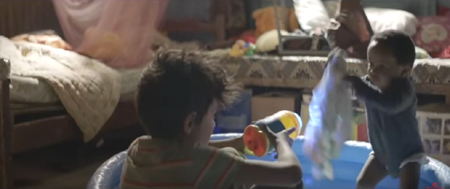
I remember that during the Cannes festival, Kore-eda’s Shoplifters and Labaki’s Capernaum were among the films most often predicted to win the Palme d’Or. In the event, Shoplifters took the top prize, and justifiably so, and Capernaum received the Jury Prize, the second highest honor. Both films center around families living in poverty, though Shoplifters moves among the members of its family and emphasizes their mutual support. Capernaum, on the other hand stays resolutely with Zain, the 12-year-old boy who is so miserable that he takes his parents to court to sue them for having brought him into a wretched existence in the Beirut slums.
Labaki, determined to expose the reasons for the sufferings of children in the poorer areas of Beirut, spent three years researching the subject. She cast actual slum-raised children rather than actors and coaxed remarkable performances from them. It seems absurd to speak of a performance from the one-year-old girl who plays Yonas, the little boy whom Zain struggles to care for when the toddler’s Ethiopian-emigré mother is arrested for lack of proper papers; still, the child seems always to be doing exactly what is natural and appropriate for the situation. The result of working with non-professionals and children was 500 hours of footage to be edited down into a two-hour film. (The production information is from an interview with Labaki in The Hollywood Reporter.)
It seems churlish to find fault with Capernaum, which certainly must be given credit for exposing a side of life that most viewers will never witness. It mixes humor and pathos with a deft hand and is undoubtedly entertaining and thought-provoking. Yet there are moments when the film’s effort to tug at our heartstrings seems a bit too obvious and overdone. Some critics have been unqualifiedly moved by the film, while others find it a bit too manipulative. I suspect that most audiences who see it in art-houses in the US will share the reaction of the Cannes audience, who gave it a 15-minute standing ovation.
The meaning of the film’s title is intriguing, and some clarification might be helpful. I have given both its original Lebanese title, Capharnaüm, and the one used in English-speaking countries, Capernaum. They are variant spellings of the same word, but with different meanings. “Capharnaüm” is French and means “a confused jumble” or “a place marked by a disorderly accumulation of objects” (Merriam-Webster). It derives from the Aramaic spelling of the Hebrew name Capernaum, the village on the Sea of Galilee where Jesus is said in the Bible to have been based during most of his ministry.
The “confused jumble” derives from the large crowds that flocked around Jesus, as in Mark: 1-2:
And again he entered into Capernaum after some days, and it was noised that he was in the house.
And straightaway many were gathered together, insomuch that there was no room to receive them, no, not so much as about the door; and he preached the word unto them.
Labaki, being a Catholic (belonging to the Lebanese Maronite Church and having been educated at St. Joseph University in Beirut), would surely have been aware of both these meanings when she made her film. The notion of a crowded jumble applies well to the environments in which the children in the film live. Certainly the children belong to the downtrodden classes to whom Jesus ministered. Possibly the reference to Jesus’ miracles, several of were reportedly performed in Capernaum, helps to justify the implausibly upbeat ending of the film.
Capernaum will be released in the US by Sony Pictures Classics on December 14.
Birds of Passage (Cristina Gallego and Ciro Guerra, 2018)
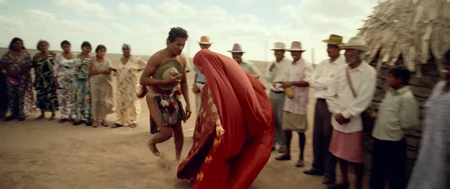
Birds of Passage is the first film directed by Ciro Guerra since his excellent Embrace of the Serpent, which was the first Colombian film nominated for a foreign-language Oscar. This time he co-directs with his wife and producer, Cristina Gallego.
Birds of Passage is a very different film from Embrace of the Serpent. The latter is set in the Colombian Amazon region, focuses on the decimation of indigenous peoples by the rubber trade, is shot in black and white, and cuts between two time periods decades apart involving two explorers guided by the same indigenous guide. Birds of Passages is set in a desert region of northern Colombia, deals with the early effects of drug-trafficking among the Wayuu people of the area, is shot in color, and follows a single extended family chronologically through five periods between the 1960s and 1980s, each announced by a dated title.
The result is a plot that is much easier to follow than that of Embrace of the Serpent. While the earlier film was based around the evocative, mysterious hunt through the jungle for a fictional sacred plant, Birds of Passage is very much anchored in the history of the early marijuana trade that the central family becomes involved in, growing very rich in the process.
In the film, the first American customers who draw the ambitious hero, Raphayet, to obtain a small amount of marijuana for them are some Peace Corps volunteers. Soon criminal traffickers become customers for Raphayet’s wares, and the roughly two decades of drug-running that follow balloon into a business that ends with a war within the family (see bottom).
The title refers to a motif that is introduced in the opening scene, when teenage Zaida, of the foremost family among the Wayuu, finishes her official transition to womanhood with a ritual dance based on bird mating rituals. Raphayet offers to dance with her (above), and the task of meeting her mother’s high dowry price includes him making his first small drug deal. The motif of real birds continues, but migrating “birds of passage” is also a local term for the American traffickers who fly in and out in small planes, bringing money in such large bundles that have to be weighed rather than counted.

As a film, Birds of Passage is not as challenging or evocative as Embrace of the Serpent. Its fascinating story, however, deals with the little-known history of the origins of the South American drug trade, the growing problem that has caused such upheaval in the region and is very much still with us.
The Orchard has the US rights, with no announced release date.
Returning for a moment to the Venice International Film Festival, three publications generated by the 2018 festival are now available for sale.
Two of these publications result from the festival’s 75th anniversary this year. Peter Cowie’s Happy 75º: A Brief Introduction to the History of the International Film Festival offers a succinct, chronological account of the festival’s facilities, organizers, guests, and winners year by year. Reading it enlivened the time spent in line before films for both David and me.
The festival also presented a large exhibition of photographs, again presented year by year, celebrating the films shown and the stars attending. This exhibition was mounted in the legendary Hotel des Bains, closed in recent years but formerly housing many of the festival’s glamorous guests. It is mainly connected in the minds of most moviegoers with Visconti’s Death in Venice, which was filmed there. There are plans to renovate and re-open it. A large catalog containing what appear to be all the photographs from the exhibition has also been published.
Finally, this year’s program, with extensive notes on the films, is available.
All of these can be ordered from amazon.it. The program can also be downloaded.
Thanks as ever to the tireless staff of the Vancouver International Film Festival, above all Alan Franey, PoChu AuYeung, Shelly Kraicer, Maggie Lee, and Jenny Lee Craig for their help during our visit.
Snapshots of festival activities are on our Instagram page.
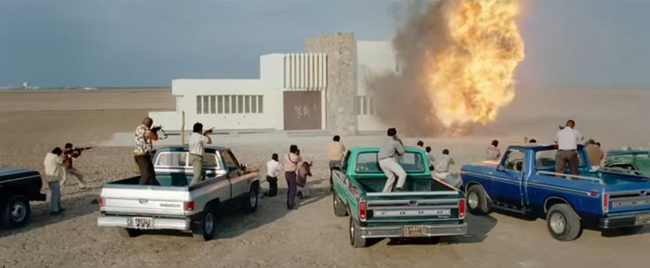
Birds of Passage













